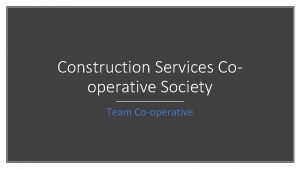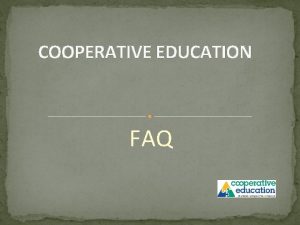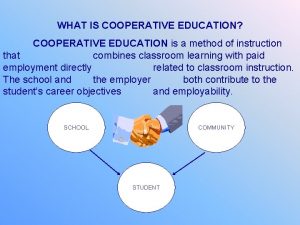COOPERATIVE EDUCATION SCHOOL INDUSTRY COOPERATIVE EDUCATION IS A









- Slides: 9

COOPERATIVE EDUCATION SCHOOL INDUSTRY

COOPERATIVE EDUCATION IS A method of instruction that blends on-the-job training with related career and technical classroom experience. Cooperative Education

Related instruction is presented in the classroom to supplement occupational experience.

GENERAL UNITS OF RELATED INSTRUCTION 1. Orientation to the part-time program 2. Finding and applying for a job 3. Employer-employee relationships 4. Progress on the job 5. Building occupational skills and knowledge.

HOW DOES CO-OP HELP YOU, THE EMPLOYER? 1. Provides you a conscientious, career-minded, part-time employee 2. Saves you training time and money 3. Fulfills an important civic responsibility by supporting and improving your school program and community 4. Cuts down employee turnover 5. Provides excellent source of future full-time employees already familiar with your business

ADVANTAGES TO STUDENTS 1. Offers job training under real conditions 2. Helps secure better employment 3. Prepares them for jobs that meet their ambitions, abilities, and interests 4. Lets them earn while they learn

HOW DO YOU PARTICIPATE IN COOPERATIVE EDUCATION? 1. Select a student from among those referred by the school. 2. Confer with the coordinator and suggest needed training and instructional materials. 3. Assist in the development and maintenance of a training plan. 4. Rate job performance of the student periodically to help determine instructional needs. 5. Plan a schedule of work that complements the student’s related classroom instruction. 6. Pay the student the normal beginner’s wage for his or

• Provide on-the-job instruction • Encourage promising young people in career development • Advise how instruction can best serve the needs of your business • Expand career education opportunities

Adapted from a presentation of the Utah State Department of Education

















